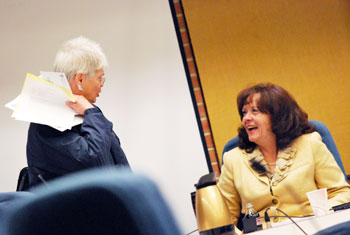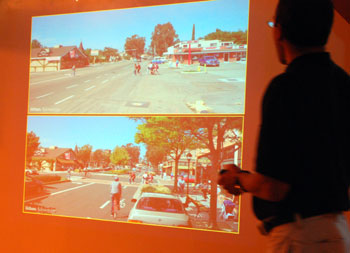City Council Mulls Zoning: Marijuana, Height
Ann Arbor City Council meeting (Oct. 18, 2010): On Monday night, the council gave an initial approval to a set of zoning laws that are intended to regulate medical marijuana use in the city. It also gave the city attorney direction to pursue the development of a license for medical marijuana facilities. All ordinances require an initial approval – a first reading – followed by a second and final reading at a later meeting.

Before the meeting, Marcia (spelling corrected) Higgins (Ward 4) chats with Sue McCormick (seated), the city's public services area administrator. McCormick is filling in for city administrator Roger Fraser, who is ill. (Photos by the writer.)
Also related to zoning was the council’s second-reading consideration of changes in the city’s zoning code for areas outside the downtown, across most of the city’s zoning classifications. The changes affect area, height and placement (AHP). The final approval of the AHP zoning overhaul had been postponed from council’s first meeting of the month, on Oct. 5, at the request of Marcia Higgins (Ward 4).
At Monday’s meeting, Higgins brought forth amendments that confined a height cap on buildings to areas adjacent to residential areas. The amendments would allow taller buildings in some non-residential areas, like Briarwood Mall. After some deliberation on the merits of the amendments, Higgins withdrew them, and the council elected to postpone the measure. With Higgins’ amendments, the proposal would be substantively different from the proposal that had already received council approval at first reading, and would thus require an additional reading before final adoption.
In other matters before the council, it was also Higgins who provided much of the impetus for conversation. Two items involved modification to the city’s budget by drawing upon the general fund reserve. One involved a $153,116 expenditure for the city’s planning department to fund corridor planning, and the other was a $160,000 item to purchase furniture for the 15th District Court, which will soon take up residence in the new municipal center at Fifth and Huron. The planning department money was approved over Higgins’ dissent, while the court’s expenditure was postponed, pending the production of an itemized list of what’s being purchased. The two items prompted discussion of the projected budget deficit for FY 2012, which the city’s CFO had estimated in May to be $5 million.
In other business, the council took the final step to enact a special assessment of property owners along Washtenaw Avenue to fund a portion of a new non-motorized path. The council also approved its part of a two-year extension to the consent agreement with Glen Ann Place, which gave site-plan approval for a project at the corner of Glen and Ann streets. Council also gave initial approval to stricter stormwater management rules for impervious surfaces in residential zoning districts.
Council chambers were filled at the start of the meeting with many members of the community who came to hear a proclamation and watch councilmembers vote on a resolution giving council’s support to a similar Michigan Civil Rights Commission resolution. The MCRC condemned the conduct of assistant attorney general Andrew Shirvell, who has written blog posts targeting Chris Armstrong, an openly gay University of Michigan student leader. The Ann Arbor city council’s resolution also calls upon the state legislature to pass a proposed comprehensive hate crime bill and a school anti-bullying law currently before the state Senate. [Full Story]






